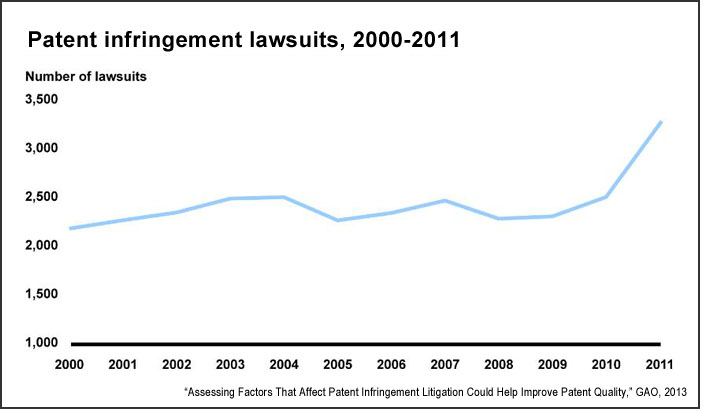Technology companies are no strangers to fighting it out in the marketplace, but the courts are increasingly a favored battleground of firms large and small. Apple and Samsung are currently suing and countersuing over smartphone patents, while Boston Scientific and Johnson & Johnson fought over coronary stents for years. Tiny VirnetX took on Apple, won big, then lost big.
The sheer number of patents that companies file to cover sophisticated devices — the iPhone is said to involve more than 200 — adds to the problem, as has the U.S. Patent Office’s willingness to grant ownership of concepts rather than tangible creations — Amazon’s notorious “one-click” patent, for example. This has opened the door to more suits, not only from the Apples and Samsungs of the world, but also what are called patent-assertion entities (PAE), nonpracticing entities (NPE) or patent monetization entities (PME) — often derided as “patent trolls,” an intentionally derogatory term invented by Intel lawyers in 1997.
Lawsuits over intellectual property (IP) have a rich history, of course, but according to a 2013 report from the U.S. Government Accountability Office (GAO), the number of cases has spiked in recent years — up 31% from 2010 to 2011 alone. The GAO suggests three factors in the rise: unclear and overly broad patents; the potential for immense damage awards; and the “increasing recognition that patents are a valuable asset.”
In its report, the GAO found that between 2007 and 2011, operating companies initiated approximately 68% of all suits, while nonpracticing entities were responsible for 19%, individuals for 8%, and research firms and universities for fewer than 3%. The percentage of suits filed by operators has been falling, however, dropping from 76% in 2007 to 51% in 2011, as those by NPEs rose. The increasing number of suits can be costly: A 2012 study by Boston University indicates that in 2011 alone, patent assertions imposed $29 billion in direct costs on defendants. “Although large firms accrued over half of direct costs, most of the defendants were small or medium-sized firms, indicating that NPEs are not just a problem for large firms,” the researchers write.
There’s a lot of nuance, however, and as with all legal matters, virtue is often in the eye of the beholder. A 2013 report by the Congressional Research Service provides good background on the debate, as does a 2013 overview by Thomas A. Hemphill of the School of Management at the University of Michigan, Flint.
Reforming the U.S. patent system while protecting innovation has long been a goal, and in 2011 President Obama signed the Leahy-Smith America Invents Act (AIA), which had broad bipartisan support. Among other changes, the act switches the United States from a “first to invent” to a “first inventor to file” system, and also limits the number of defendants in lawsuits. But the latter provision has had the unintended consequence of increasing the caseload. To address this and other concerns, Congress has in recent years considered several different legislative strategies, but remained stalemated, in part because of opposition from pharmaceutical and biotechnology companies.
A 2014 NBER paper, “Patent Trolls: Evidence from Targeted Firms” by Lauren Cohen of Harvard Business School, Scott Duke Kominers of Harvard University and Umit Gurun of University of Texas at Dallas, analyzes the behavior of nonpracticing entities. It also examines the characteristics of companies that are likely to be targeted, in addition to the effects of patent claims by NPEs on a firm’s innovation practices.
The key findings include:
- While the number of cases brought by practicing companies has been constant at about 150 a year, the number of cases in which non-practicing entities sue grew from 11 in 2001 to 336 in 2011.
- Non-practicing entities tend to sue firms that have significant cash reserves or have recently experienced positive cash shocks: “A one standard-deviation increase in cash level increases the probability of being sued by an NPE by 11%. Given that the mean probability is 2%, this is more than a fivefold increase.”
- Companies with smaller legal teams and a higher number of ongoing legal cases are more likely to being sued by NPEs. This suggests that they “target firms with a higher likelihood of settling,” thus “maximizing the expected profitability of winning.”
- NPEs do not appear to take into account if profits stem from the patent in question itself or from other activities of the firm. “An NPE’s probability of suing a firm increases with the firm’s profits even if those profits are derived from segments exogenous to the patent under litigation.”
- Companies that lose cases to NPEs spent on average $211 million less on research and development in the years after the litigation compared to targeted firms that won. “Furthermore, in the years following litigation, firms against whom cases are dismissed produced 63.52 more new patents, and these new patents received 723.98 more citations, relative to the group of firms that suffered the cost of NPE litigation.” This suggests that NPEs “have a real and negative impact on innovation for United States firms.”
“The stakes of how to organize intellectual property disputes are massive,” the authors state. “If the United States becomes a less desirable place to innovate because NPEs are left unchecked, innovation and human capital and the returns to that innovation and human capital will likely flee overseas.” Based on their findings, they suggest that the “marginal policy response should be to more carefully limit the power of NPEs or, in the framework of our model, increase the cost of bringing suit against commercializers of innovative ideas.”
Keywords: technology, law, business, patents, science, entrepreneurship


Expert Commentary